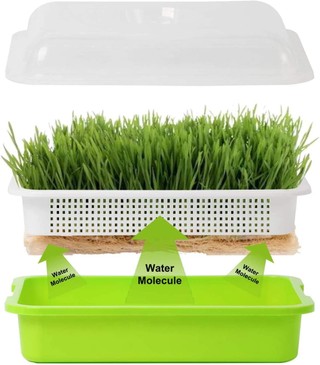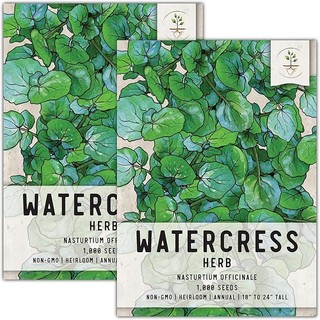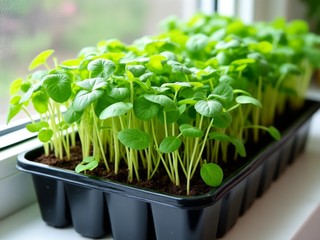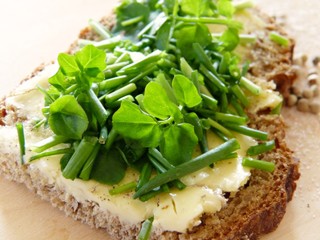How to grow watercress indoors (beginner-friendly)

Watercress, a nutrient-rich and water-loving perennial, is perfect for indoor container gardening.
With its peppery taste and ease of cultivation, it’s an excellent choice for anyone looking to grow fresh greens year-round.
1. Prepare the container setup
Watercress needs its roots to stay wet, so a double-container setup works best.
-
Pick two containers: The smaller one should have drainage holes, and the larger one should hold water. Make sure they can nest together.
-
Prepare the inner container: Line the bottom with a coffee filter or paper towel to stop soil from escaping. Fill it with moist potting soil.
-
Set up the system: Place the smaller container inside the larger one.
-
Add water: Fill the outer container with water just below the bottom of the smaller container. This keeps the soil moist without drowning the roots.


2× BPA-free nursery trays with covers
- Deeper than normal trays, perfect for herbs with deep roots
- Water using spray bottle or fill bottom tray with water
2. Plant the seeds
Follow these simple steps to grow watercress from seeds:
-
Fill a shallow container with moist potting soil.
-
Sprinkle the seeds over the soil and cover them lightly with a thin layer of soil.
-
Place the container in a spot where the temperature stays between 50–60°F.
-
Keep the soil moist at all times.
-
When seedlings are a few inches tall, transplant them. Use one plant per 8-inch container, or three per 12-inch container, spacing them apart.
Using stem cuttings instead of seeds
To propagate watercress from stem cuttings:
-
Take a cutting from an existing plant, or buy watercress from the store and use a stem.
-
Place the cut end in a jar of water until roots grow at least 1 inch long.
-
Fill your container with pre-moistened potting soil or another growing medium.
-
Plant the rooted cuttings carefully—1 cutting per 8-inch pot or 3 per 12-inch container.
What seeds to use
Not all watercress seeds are the same, and selecting the right type can make a big difference in your success, especially when growing indoors.
There are a few varieties of watercress seeds you might come across:
-
Common watercress (nasturtium officinale): This is the most widely known and cultivated type, ideal for indoor growing. It has the classic peppery taste and thrives in waterlogged conditions.
-
Garden cress (lepidium sativum): Although it’s often confused with watercress, garden cress grows faster and requires less water. However, it’s a different plant species and is better suited to traditional soil growing rather than the waterlogged conditions true watercress prefers.
-
Upland cress (barbarea verna): This variety is more tolerant of drier soil and prefers less water, making it easier for those who struggle to maintain the wet conditions needed for common watercress. However, it lacks the same aquatic nature and flavor intensity.
For true watercress, nasturtium officinale seeds are your best bet. Make sure to double-check seed labels to avoid accidental purchases of garden or upland cress. Our recommendation is to use the seeds below.

Seed Needs’ watercress seeds (1,000 seeds)
- Non-GMO
- Heirloom
- Two packs of 500 seeds each
What potting mix to choose
Watercress grows best in a soilless potting mix that retains moisture. Avoid using garden soil or regular potting soil, as they don’t offer the right conditions for watercress to thrive.
-
Recommended mix: Use a blend of vermiculite or perlite mixed with peat moss. This combination helps maintain moisture while allowing the roots to breathe.
-
Why soilless? Watercress naturally grows in waterlogged environments. A soilless mix mimics these conditions by holding water without compacting the roots, which can happen with regular soil.
-
Hydroponic systems: Commercial growers often use water-based systems to grow watercress. While this method is effective, it requires specialized equipment and constant water circulation, which may not be practical for home growers.
Light requirements
Watercress is a cool-season plant, and while it thrives in lower temperatures, it still needs adequate light to grow well indoors.
-
Natural light: Watercress needs around 4 hours of indirect sunlight per day. Place it near a bright window, such as an east- or north-facing window, where it can get gentle sunlight without being exposed to harsh, direct rays. Afternoon sun can be too intense and may cause the leaves to wilt or burn.
-
Artificial light: If you don’t have enough natural light, especially during winter months or in darker spaces, you can use grow lights to ensure your watercress gets what it needs. Position LED or fluorescent grow lights about 6–12 inches above the plant. Set the lights to be on for 8–12 hours a day, which will simulate the same amount of light the plant would naturally receive without overexposing it.
-
Temperature considerations: Watercress thrives in cooler conditions, with a preferred range of 50–60°F. If you’re using artificial lights, ensure they don’t generate too much heat that could disrupt these cooler growing conditions. LED lights are a good option because they produce very little heat.
-
Rotating the plant: If your watercress is receiving light from only one side, rotate the pot every few days to promote even growth and prevent the plant from leaning too much toward the light.
Quick recap
-
Watercress needs 4 hours of indirect sunlight.
-
Use grow lights if natural light is insufficient.
-
Rotate the plant every few days for even growth.
Watering and moisture control
Watercress thrives in consistently moist conditions, but it’s important to manage moisture properly to prevent issues like root rot or water stagnation.
Here’s how to keep your watercress healthy:
-
Watering the seeds: After planting, water the seeds lightly to keep the soil moist but not soaked. Use a spray bottle or a watering can with a fine nozzle to avoid disturbing the seeds. Ensure the soil remains damp, similar to a wrung-out sponge, especially during the germination period.
-
Keep the growing medium consistently moist: Watercress plants need their roots to stay wet at all times. Check the soil’s moisture daily by touching the surface—it should feel damp but not muddy. If the top layer feels dry, water lightly to rehydrate the soil.
-
Maintain water levels in the double-container setup: Always keep a couple of inches of water in the larger container to provide consistent moisture to the inner pot. Add fresh water daily or every other day to prevent stagnation and avoid bacteria buildup.
-
Bottom watering for healthier roots: Fill the outer container or tray with water and allow the soil to absorb moisture from below. This method helps keep the soil surface dry, reducing the risk of mold or mildew, while ensuring the roots stay hydrated.
-
Prevent water stagnation: If you’re using a double-container setup, it’s important to refresh the water in the outer container every 1–2 days to avoid algae, bacteria, or unpleasant odors. If you notice any discoloration or smells, clean the container and replace the water immediately.
Humidity considerations
Watercress is an aquatic plant that thrives in humid environments, which mimic its natural habitat near streams and wetlands.
If you live in a dry area or during colder months with indoor heating, misting the plants with water daily can help maintain proper humidity.
Additionally, placing your container on a tray filled with water and pebbles can naturally increase humidity around the plant. Ensure the water level stays just below the surface of the pebbles to prevent waterlogging the roots.
Quick recap
-
Keep soil moist but not soggy.
-
Change the water every 1–2 days to prevent stagnation.
-
Mist plants in dry environments to increase humidity.
We prefer this spray bottle for misting. It’s made out of glass and feels high quality.

16-oz glass bottles with plastic spray triggers
- BPA-free, dishwasher-safe
- Chalkboard labels
- Squeeze-handle pump can be set to stream or spray settings
Next, check out our articles on how to care for your watercress plants and ways to use your fresh watercress in your kitchen.


